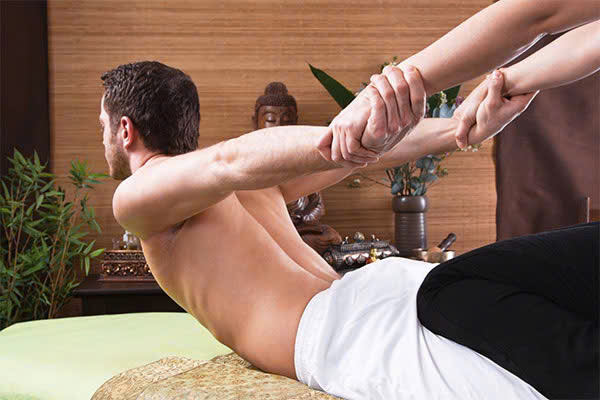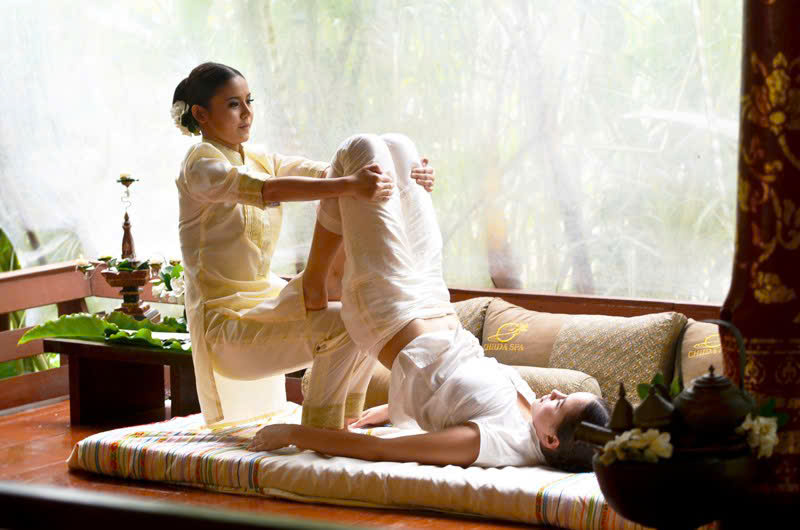Thai Massage : 6 Benefits, Techniques, What to Expect
What is Thai massage? Thai massage, also known as “Nuad Bo-Rarn,” is an ancient form of therapeutic bodywork originating in Thailand. It’s a blend of acupressure, yoga-like stretching, and energy channel manipulation that aims to promote overall wellness, relieve tension, and enhance flexibility. This traditional practice involves deep rhythmic compressions and stretches and is often performed on a mat rather than a massage table, allowing for greater body movement.

What is Thai Massage
Thai massage is much more than just a physical treatment; it’s a holistic approach that combines elements of both physical therapy and meditation. Rooted in Buddhist principles and influenced by Ayurvedic medicine from India, this unique form of massage emphasizes balancing the body’s energies, which practitioners believe can lead to physical, emotional, and spiritual health.
The Historical Context of Thai Massage
The history of Thai massage dates back over 2,500 years to the time of the Buddha. It was developed by Jivaka Kumar Bhaccha, who is considered the father of traditional Thai medicine. Historically, it served monks and laypeople alike, focusing on healing not just physical ailments but also emotional and mental ones.
In its early days, Thai massage was closely tied to spiritual practices. Monks would use these techniques to help maintain their own physical well-being while meditating and seeking enlightenment. Consequently, the methods evolved through generations, integrating various influences from neighboring cultures—most notably Indian and Chinese traditions.
Key Components of Thai Massage
A typical Thai massage session incorporates several key components that distinguish it from other forms of massage:
- Stretching: Incorporating gentle yoga-like stretches into the routine helps enhance flexibility, improve circulation, and relieve muscular tension.
- Energy Lines (Sen): Practitioners believe there are energy lines throughout the body, known as Sen lines. Thai massage focuses on balancing energy flow along these channels by applying pressure at specific points, similar to acupuncture.
- Breath Work: Breath plays a vital role in Thai massage. Clients are encouraged to focus on their breathing to enhance relaxation and connection with their bodies during the session.
- Rhythmic Pressure: Instead of using oils like many Western massages, Thai massage relies heavily on the practitioner’s hands, elbows, knees, and feet to apply rhythmic pressure, deeply relaxing tight muscles.
Common Myths Surrounding Thai Massage
Despite its popularity, many misconceptions surround Thai massage. One prevalent myth is that it is solely about pain or discomfort. While some may experience brief sensations of intensity due to deep tissue manipulation, the goal is never to cause pain. Instead, practitioners strive to ensure the process is comfortable and beneficial, guiding clients through each step.
Another myth is that Thai massage is only suitable for physically flexible individuals. On the contrary, Thai massage can cater to people of all body types and flexibility levels. Adjustments can be made according to individual needs, making it accessible to almost anyone looking to benefit from its therapeutic effects.

6 Benefits of Thai Massage
Thai massage offers an array of benefits that extend beyond mere relaxation. By understanding these advantages, you may find yourself even more inclined to incorporate this practice into your wellness routine.
Improved Flexibility and Range of Motion
One of the most notable benefits of Thai massage is its ability to enhance flexibility and range of motion.
By integrating various stretching techniques, Thai massage allows the body to experience movements that may not occur naturally in day-to-day life. These stretches work deeply within muscle fibers and joint areas, promoting relaxation and elasticity.
Individuals suffering from stiffness or inflexibility, whether from desk jobs or athletic training, may find significant relief through regular sessions. As the body becomes more accustomed to these stretches, not only does physical flexibility increase, but the mental barriers around movement may lessen, leading to newfound freedom in exploring physical activity.
Stress Reduction and Mental Clarity
Thai massage takes a holistic approach to wellness, engaging the mind and spirit alongside the body.
Through rhythmic pressure and stretching, the nervous system is calmed, releasing tension stored in the body. This process can significantly lower stress levels and promote feelings of tranquility.
Moreover, the focus on breath throughout the session encourages mindfulness and present-moment awareness. This meditative aspect can lead to improved mental clarity, helping you navigate daily tasks with increased focus and insight.
In our fast-paced world, carving out time for self-care is essential, and utilizing Thai massage as a tool for reducing stress can yield long-lasting benefits.
Enhanced Circulation
Another remarkable benefit is improved blood circulation. Thai massage utilizes rhythmic compression techniques to stimulate blood flow and enhance overall circulation throughout the body.
As the practitioner works through various pressure points, it generates warmth, encouraging blood vessels to expand and allow for better oxygenation of tissues. This enhanced circulation can aid in faster recovery from injuries, decreased muscle soreness, and greater overall vitality.
Moreover, individuals experiencing chronic issues with circulation, such as cold extremities or numbness, may find significant improvement following regular sessions.
Detoxification and Immune Support
The stimulation of lymphatic drainage through Thai massage can lead to detoxification of the body.
Lymph fluid plays a crucial role in immune function and eliminating waste products and toxins from bodily tissues. By activating lymph nodes and encouraging movement through the lymphatic system, Thai massage may enhance immune response, contributing to greater vitality and overall health.
Post-session, individuals may notice an increased feeling of lightness, as the body effectively eliminates toxins and supports overall wellness.
Pain Relief and Muscle Tension Release
For many, one of the primary reasons for seeking massage is to alleviate pain, and Thai massage excels in this regard.
The combination of stretching, pressure application, and rhythmic movement has been shown to relieve muscle tension and soreness, particularly in areas such as the lower back, neck, and shoulders.
Those experiencing chronic pain conditions like fibromyalgia or arthritis may also find solace in the gentle yet effective techniques employed in Thai massage. Regular sessions can contribute to long-term pain management and improved quality of life.
Emotional Well-Being and Energy Balance
Emotional health is a critical component of overall wellness, and Thai massage plays a unique role in balancing emotions.
As pressure is applied to various energy lines, the body releases stored emotional blockages, providing an opportunity for healing and renewal. Many individuals report feeling liberated from negative emotions or mental fog after a session, fostering greater emotional balance and resilience.
The emphasis on breath work further enhances emotional release, encouraging practitioners to connect with their feelings and explore self-awareness in a supportive environment.
How Thai Massage Works
Understanding how Thai massage works can further deepen your appreciation for this timeless practice.
The Role of Breathing
Breathing is a fundamental aspect of Thai massage, serving as a bridge connecting the mind, body, and spirit.
Throughout a session, practitioners often guide clients to synchronize their breaths with the movements and stretches being performed. This practice fosters relaxation and enhances the overall experience. As clients exhale, they are encouraged to release tension, allowing for deeper stretches and a more profound sense of relaxation.
Breathing, when paired with the physical techniques of Thai massage, creates a symbiotic relationship where the body responds positively to deepened awareness and focused attention.
The Application of Pressure and Point Techniques
At the heart of Thai massage lies the skillful application of pressure and point techniques.
Much like acupuncture, Thai massage employs the use of pressure on specific points along the body’s Sen lines. Practitioners utilize their hands, forearms, elbows, knees, and feet to apply this pressure, creating a deeply invigorating experience.
This targeted manipulation helps clear energy blockages, allowing for unimpeded energy flow throughout the body. When energy flows harmoniously, it promotes a sense of balance, vitality, and well-being.
The Importance of Body Mechanics
Practitioner body mechanics play a critical role in delivering effective Thai massage.
Trained therapists utilize their body weight, leverage, and balance to perform stretches and compressions without undue strain on their bodies. This aspect ensures that treatments remain sustainable and enjoyable for both parties.
Understanding how to shift weight effectively and move efficiently is essential for practitioners, allowing them to tailor each session based on client needs while minimizing fatigue.
Integrating Mindfulness and Intuition
An essential element is the integration of mindfulness and intuition into the practice.
As therapists engage with their clients, they develop a heightened sense of awareness regarding the body’s responses. This intuitive understanding enables them to adapt techniques on-the-fly, ensuring that each session feels unique and personalized.
Many practitioners emphasize the importance of tuning into both the client’s needs and their own senses, creating an atmosphere conducive to healing and relaxation.

Why Need Choose Thai Massage
With so many massage techniques available today, why should you choose Thai massage?
A Holistic Approach to Wellness
Thai massage is built upon a foundation of holistic wellness that transcends mere physicality.
Instead of treating isolated symptoms, practitioners aim to restore balance to the entire system by addressing physical, emotional, and energetic needs.
This comprehensive perspective attracts many individuals seeking a complete rejuvenation experience rather than just a temporary fix. With every session, clients have the opportunity to explore deeper layers of themselves and enhance their overall well-being.
Versatile Treatment for All Ages
Thai massage’s versatility makes it suitable for individuals of varying ages and fitness levels. Whether you are an athlete needing recovery support or a senior seeking gentle relief, Thai massage can be tailored to suit your needs.
The adaptability of the techniques means that everyone can benefit from the soothing and invigorating properties offered through this ancient practice. Additionally, as it requires minimal equipment, services can easily be provided in various settings—from spas to wellness centers or even at home.
Promoting Self-Awareness and Connection
Choosing Thai massage invites you to cultivate a deeper connection with your body and self-awareness.
During a session, clients are encouraged to tune in to how they feel physically and mentally, promoting a sense of mindfulness that extends beyond the massage room. This self-awareness can lead to healthier lifestyle choices, improved emotional regulation, and a stronger sense of agency.
Ultimately, the benefits gained from practicing mindfulness can ripple into daily life, empowering individuals to make conscious decisions that support their overall well-being.
A Path to Stress Relief and Relaxation
Amidst the challenges of modern living, stress relief is a pressing concern for many. offers a sanctuary—a space dedicated to relaxation and self-care.
By encouraging deep relaxation and restorative practices, individuals leave each session feeling lighter and recharged. The combination of physical techniques and mental clarity serves as a counterbalance to life’s demands.
Choosing Thai massage provides an invaluable opportunity to prioritize self-care, reconnect with oneself, and emerge refreshed and ready to tackle whatever life throws your way.https://jobedubaispa.com/aromatherapy-massage/https://jobedubaispa.com/aromatherapy-massage/
Conclusion
Thai massage serves as a powerful tool for nurturing well-being on multiple levels. From enhancing physical flexibility to promoting emotional balance, the myriad benefits are truly compelling.
Understanding , its techniques, and what to expect empowers individuals to make informed choices regarding their wellness journey.
Whether you’re seeking relief from stress, pain management, or simply wanting to enhance your overall quality of life, Thai massage can provide an enriching experience that resonates far beyond the surface.
Embrace this ancient practice as a pathway toward holistic health, and let the healing begin. see the spa map on here https://maps.app.goo.gl/2gfYPJNYythhZesU6?g_st=com.google.maps.preview.copy
